![]()
![]()
![]()
Use LEFT and RIGHT arrow keys to navigate between flashcards;
Use UP and DOWN arrow keys to flip the card;
H to show hint;
A reads text to speech;
22 Cards in this Set
- Front
- Back
|
Gonorrhea: Pathogen
|
N. gonorrhoeae
(gonococcus bacteria) one of two pathogenic spices of Neisseria that colonize humans (the other causes meningitis) gram-negative diplococci |
|
|
N meningitidis vs N gonorrhoeae
|
both are Neisseria pathogens that only infect humans
N meningitidis causes meningitis in humans, and can potentially expand into pneumonia and arthritis. The major difference is that N meningitides has a capsule, while gonorrhea culture (GC) does not. Since GC does not have a capsule, a vaccine cannot be created for gonorrhea. |
|
|
Gonorrhea: Pathogenesis
|
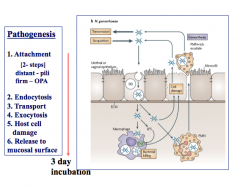
infection via DIRECT physical contact
2 major mechanisms of adherence to the epithelial membrane: Pili- have distant/loose attachment OPA protein- which makes a firm, strong attachment after adherence, and getting endocytosed, the bacteria is transported to the basolateral surface and transported into the extracellular matrix. From here it can get into the bloodstream and disseminate. Macrophages and neutrophils phagocytose the bacteria and we get tissue damage from macrophage release of cytokines. The macrophages and neutrophils then return to the epithelial surface and are released. Because these immune cells now contain the bacteria, they are able to transmit the disease upon contact with other people's epithelium. |
|
|
Gonorrhea: Treatment
|
Ceftriaxone (125 mg IM)
usually coupled with Doxycycline (100 mg orally) since gonorrhea generally travels with other diseases, such as chlamydia, which is treated with doxycycline. Other forms of treatment are preventative education, as well as testing sexual partners of infected individuals. |
|
|
3rd generation cephalosporin drugs
|
inhibit cell wall synthesis in bacteria, and in treating Gonorrhea
3rd generation refers to the fact that the first two variations of these drugs became resistant, and there drugs are slight modifications of those earlier versions. |
|
|
why is reinfection so common in gonorrhea?
|
antigenic variation
1. variation in the OPA protein antigen 2. variation in the Pil protein |
|
|
Gonorrhea: OPA Protein Antigen Variation
|
variation occurs with respect to the OPA antigen because the pathogen can turn transcription of the OPA protein on, then off, then on, and so on.
Since the immune system has a hard time responding to antigen that is not always present, reinfection can occur (since memory cells are not properly formed) |
|
|
Gonorrhea: Pili Protein Variation
|
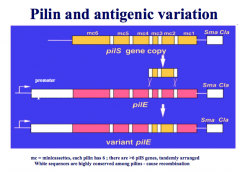
Variation in pilin proteins occurs due to recombination of genes.
These genes are made up of highly variable sequences called mini cassettes (pink sections) and conserved regions (white sections). Each pilin gene has six mini cassettes the expressed and silent genes all have different mini cassettes (highly variable), but these genes do have the same conserved sequences. Silent genes don't have a promotor so they're not expressed. Recombination occurs when conserved* regions recombine, and the mini cassettes from the silent gene can now be expressed because they are now in line with the promotor on the expressed gene. these new variants of pilin allow N.g. to reinfect its host because the host immune system cannot recognize the variant. |
|
|
Gonorrhea: Symptoms
|
Men are more likely to be urogenitally symptomatic*, and generally present with urethritis* (inflamed urethra), and a purulent discharge* from the tip
Women are more likely to be urogenitally asymptomatic* and will generally have NO discharge. They are more likely to present with disseminated gonococcal disease* -This leads to skin lesions* and transient joint pain* |
|
|
Diagnosing Gonorrhea
|
Gram Stains:
-if positive for gonorrhea will show multi-lobed neutrophils filled with gram-negative diplococci. -can ONLY be used for diagnosis in men because gram-negative bacteria are not found in the male urethra under normal conditions. Culturing on CAP-Thayer Martin Agar -needed for females because vaginas have a ton of bacteria. -suppresses the growth of all other bacteria except Neisseria bacteria. -can also add an Oxidase Reagent* (Black Colonies= Gonorrhea) |
|
|
Chlamydia: Pathogen
|
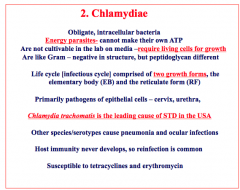
Chlamydia Trachomatis
Obligate, intracellular bacterium Energy Parasite- cannot make its own ATP (this means the bacteria cannot be cultured in the lab; they require living cells to grow |
|
|
Chlamydia: Pathogenesis
|
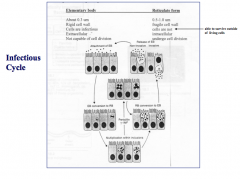
Involves 2 growth forms: the Elementary Body (EB) and the Reticulate Body (RB)
The EB is the form of the pathogen that is spread from individual to individual during sexual intercourse. EBs are very small particles, and attach tot he epithelial cells. They are phagocytized into the cell, and slowly begin growing and changing into the larger RB forms. *The RB's have dividing capacity; EB's have no dividing capacity* After division, the RB's can convert back into EB's. The EB's are then released and continue on to infect more epithelial cells. *The interconversion between EB's and RB's is unique to chlamydia* |
|
|
Chlamydia incubation time
|
the incubation time for chlamydia is 5-10 days
This is notable because gonorrhea and chlamydia are often transmitted together, and the incubation time for gonorrhea is only 2-5 days. This means that if you're only treating gonorrhea and the gonorrhea goes away, chlamydia could still appear about a week later. -this is sometimes referred to as post-gonococcal urethritis** |
|
|
Chlamydia: Symptoms
|
major symptoms are Cervicitis (leading to cervical discharge) in females, and Urethritis (leading to urethral discharge) in males
|
|
|
Diagnosing Chlamydia
|
Gram Stains:
-ineffective Cultures -cannot be used because chlamydia cannot be cultured NAAT Test -can be done directly from rectal, oral, or urogenital swab samples -pretty useful |
|
|
Chlamydia Treatment
|
commonly treated with Doxycyline and other tetracyclines.
|
|
|
Syphilis: Pathogen
|
Treponema Pallidum
Spirochete- a spiral shaped bacterium Gram-Negative Like chlamydia, it cannot be cultured, and only humans are infected |
|
|
Syphilis Incubation Time
|
three weeks before symptoms of primary syphilis present
|
|
|
Syphilis Pathogenesis
|
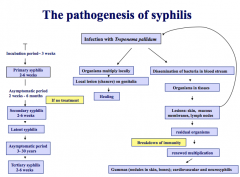
once infection occurs, there is an incubation period of 1-3 weeks before any symptoms are seen. The pathogen multiplies and when skin lesions begin to first appear, PRIMARY SYPHILIS has begun.
These skin lesions are usually called Chancers* which present as firm, painless, non-itchy skin ulcerations. During and after primary syphilis, the pathogen will enter the bloodstream and pass throughout the body. If no treatment occurs, the lesions may heal, and the asymptomatic period begins, which can last 2 weeks-6 months. After this asymptomatic period, skin lesions will appear on random parts of the body since the pathogen has travelled through the blood stream. When this secondary set of symptoms occurs, SECONDARY SYPHILIS has begun and can last for 2-6 weeks. *in both primary and secondary syphilis, the lesions contain the pathogen, and therefore the pathogen can be passed to other individuals* If the condition is again left untreated, the patient will enter another asymptomatic period, which can last from 3-30 years. During this time, residual organisms cause a breakdown of immunity until symptoms for tertiary syphilis appear. These symptoms will again last two to 6 weeks |
|
|
Symptoms of Primary Syphilis
|
chancre on the genitalia
(firm, painless, non-itchy skin ulceration) |
|
|
Symptoms of Secondary Syphilis
|
reappearance of chancre on the genitals, skin rash, and enlarged lymph nodes
symptoms of both secondary and tertiary syphilis mimic symptoms associated with many other diseases - "great imitator" |
|
|
Symptoms of Tertiary Syphilis
|
hummus (nodules on the skin and bones), cardiovascular and neurosyphilis
symptoms of both secondary and tertiary syphilis mimic symptoms associated with many other diseases - "great imitator" |

